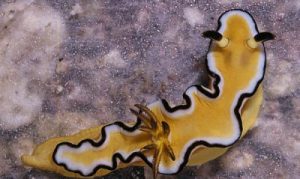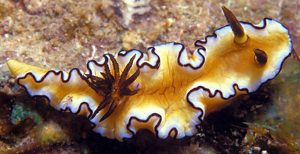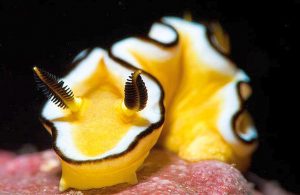Glossodoris sibogae is a less common species of sea slug found in the tropical Pacific Ocean that is known in Indonesia, Fiji, and more commonly in French Polynesia.
Similar in shape and coloration to Glossodoris atromarginata, there is no sure way to differentiate the two species without dissection of the animals to examine their teeth. The radular teeth of Glossodoris sibogae are about half the size of Glossodoris atromarginata’s.
Glossodoris sibogae has a distinctly intense bright yellow color in the mantle and foot. The thin black edge that borders the sinuous mantle is always separated from the bright yellow to brownish yellow body of the back by a wide, bright white line.
Like Glossodoris atromarginata, Glossodoris sibogae is a peaceful species that spends it’s waking hours searching out and feeding on sponges.
Glossodoris sibogae is found in depths of 10 feet, to over 60 feet where they have been seen feeding on a variety of colored sponges on the shallow seaward reefs.
Although Glossodoris sibogae is found primarily in rocky coastal coral reef areas with substantial growths of sponges, hard and soft corals, they have also been seen in areas with sandy, silty bottoms.
Glossodoris sibogae like many sea slugs, are believed to secrete trace amounts of poisonous toxins as a defense mechanism when threatened, and caution should used not be house them with aggressive predators that could see them as a meal.
Glossodoris sibogae is a relatively large sea slug that can reach almost 4 inches in length. They have a have a radula about half the size of Glossodoris atromarginata and a long oral tube that allows them to probe deep into partly buried sponge colonies that are partly buried under other growths, so they can feed.
Because of their specialized feeding habits, they have a relatively short life expectancy in an aquarium environment. They are apparently voracious eaters of sponges and are best housed in an established reef tank of at least 55 gallon capacity with plenty of mature live rock, a sandy substrate, and obviously plenty of sponge growth.
Glossodoris sibogae need a moderate amount of water movement and at least one powerhead is recommended in the system to keep them happy. Like most invertebrates, Glossodoris sibogae is very sensitive to rapid changes in water quality and requires stable water conditions.
They are especially sensitive to higher levels of nitrates and cannot tolerate any amount of copper in the system. When purchased they should be slowly drip acclimated with the lights off when introduced into a new reef system.
In established reef aquariums, regular spawnings often occur when Glossodoris sibogae are maintained together.
Glossodoris sibogae is a specialty feeder that requires live sponges in order to thrive. Lacking a steady supply of live sponges in their diet, they will usually not eat enough of anything else to thrive and will slowly starve.
Because of this and their short life span, only expert tropical fish keeping enthusiasts should attempt to maintain this species.
Glossodoris sibogae is occasionally available to tropical fish keeping enthusiasts from specialty shops, Nudibranch forums, and online from a variety of sources.
Minimum Tank Size: 55 gallons
Aquarium Type: Established Reef
Care Level: Moderate
Temperament: Peaceful
Aquarium Hardiness: Relatively hardy
Water Conditions: 72-78°F, dKH 8 to 12, pH 8.1-8.4, sg 1.023-1.025
Max. Size: 3.9″
Color Form: Yellow, White, Brown, Black
Diet: Specialty Carnivore
Compatibility: Reef Compatible
Origin: Tropical Pacific Ocean
Family: Chromodorididae
Lifespan: Unkonwn
Aquarist Experience Level: Expert Only





